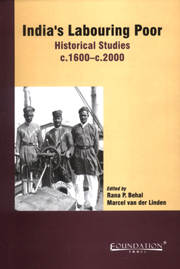Book contents
- Frontmatter
- Contents
- Notes on Contributors
- Frontispiece
- Preface
- Introduction
- Working Across the Seas: Indian Maritime Labourers in India, Britain, and in Between, 1600–1857
- The Brickmakers' Strikes on the Ganges Canal in 1848–1849
- On the Move: Circulating Labour in Pre-Colonial, Colonial, and Post-Colonial India
- Mobility and Containment: The Voyages of South Asian Seamen, c. 1900–1960
- Power Structure, Discipline and Labour in Assam Tea Plantations during Colonial Rule
- “Following Custom”? Representations of Community among Indian Immigrant Labour in the West Indies, 1880–1920
- Masculinity, Respect, and the Tragic: Themes of Proletarian Humor in Contemporary Industrial Delhi
- Stretching Labour Historiography: Pointers from South Asia
- DOCUMENT
- Select Bibliography
Mobility and Containment: The Voyages of South Asian Seamen, c. 1900–1960
Published online by Cambridge University Press: 05 January 2012
- Frontmatter
- Contents
- Notes on Contributors
- Frontispiece
- Preface
- Introduction
- Working Across the Seas: Indian Maritime Labourers in India, Britain, and in Between, 1600–1857
- The Brickmakers' Strikes on the Ganges Canal in 1848–1849
- On the Move: Circulating Labour in Pre-Colonial, Colonial, and Post-Colonial India
- Mobility and Containment: The Voyages of South Asian Seamen, c. 1900–1960
- Power Structure, Discipline and Labour in Assam Tea Plantations during Colonial Rule
- “Following Custom”? Representations of Community among Indian Immigrant Labour in the West Indies, 1880–1920
- Masculinity, Respect, and the Tragic: Themes of Proletarian Humor in Contemporary Industrial Delhi
- Stretching Labour Historiography: Pointers from South Asia
- DOCUMENT
- Select Bibliography
Summary
LASCARS IN A SEGMENTED LABOUR MARKET
In the political and economic context of imperialism, the enormous nineteenth-century expansion of shipping within and beyond the Indian Ocean facilitated the development of a new and increasingly transcontinental regime of labour circulation. The Indian subcontinent, it is well known, emerged as a seemingly inexhaustible source for plantation, railway, and port labour in British colonies across the globe. Moreover, the new and predominantly seaborne “circulatory regime” itself relied to a considerable extent on the labour power of South Asian workers, on the lascar, as the maritime counterpart of the “coolie” labourer was called.
The number of Indian workers on the decks and in the engine rooms and saloons of merchant vessels grew considerably along with the rise of longdistance steam shipping in the last quarter of the nineteenth century. During the interwar years, on average about 50,000 South Asian seamen were employed on British merchant vessels alone and many thousands more by German and other European shipping companies. In this period, lascars made up roughly a quarter of all ratings on British merchant ships – a proportion that remained fairly stable well into the 1960s, despite the end of the colonial regime.
A sailor's work implies extraordinary mobility across territorial frontiers and cultural spheres. It is, therefore, tempting to conjure up images of a transcultural, uncontainable, and freely roaming proletariat of the seven seas. However, the social history of South Asian steamship workers sits rather uneasily with apologetic “globalization” narratives that celebrate unending beach parties of happy “hybridity” or revel in “the Dance of the Flows and the Fragments”.
- Type
- Chapter
- Information
- India's Labouring PoorHistorical Studies, 1600-2000, pp. 111 - 142Publisher: Foundation BooksPrint publication year: 2007



